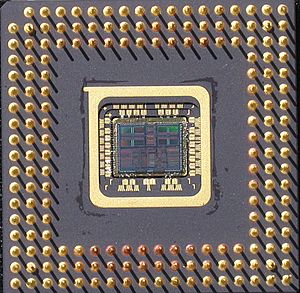MIPS architecture facts for kids
The MIPS architecture is a special set of instructions, or commands, that computers use. It was created at Stanford University in 1981. At first, MIPS stood for "Microprocessor without Interlocked Pipeline Stages." This name describes how it processes commands very efficiently.
MIPS is a type of RISC architecture. This means all its commands are the same length. This design makes the computer chip simpler and allows it to work very fast. Initially, MIPS used a 32-bit system. But from 1991, it switched to a more powerful 64-bit system.
Contents
What MIPS Is Used For
MIPS architecture is found in many everyday devices. It's especially common in what are called "embedded systems." These are computers built into other machines to do specific tasks.
Devices Using MIPS
- Routers: These devices help connect your home to the internet.
- Residential gateways: Similar to routers, they manage your home network.
- Video game consoles: Famous examples include the Sony PlayStation, PlayStation 2, and PlayStation Portable.
- Windows CE devices: These are older portable devices like some handheld computers.
In the past, MIPS was also used in computers made by companies like SGI. During the 1980s and 1990s, many other big tech companies also used MIPS designs. It was estimated that about one out of every three RISC microprocessors made during that time was a MIPS design.
How MIPS Works
MIPS is known for its simple and efficient design. This simplicity helps computers process information quickly.
Instruction Set
An instruction set is like a vocabulary list for a computer's brain (the microprocessor). Each word in this vocabulary tells the computer to do a specific action. MIPS has a smaller, simpler vocabulary compared to some other architectures. This makes it faster to learn and use for the computer.
RISC Design
RISC stands for "Reduced Instruction Set Computer." This means MIPS uses a smaller, more basic set of instructions.
- Simple commands: Each instruction does one simple task.
- Same length: All instructions are the same size. This makes it easier for the computer to read and process them quickly.
- Fast processing: Because the instructions are simple and uniform, the computer can run them very fast. This is like having a short, clear checklist for every task.
History of MIPS
The MIPS architecture was created by a team at Stanford University. It was designed to be a very efficient way for computers to work.
Early Development
The first MIPS design came out in 1981. It was a new way to build computer processors. The goal was to make processors that could run very fast by simplifying their internal structure.
Evolution to 64-bit
Initially, MIPS processors handled data in 32-bit chunks. This means they could process 32 bits of information at a time. In 1991, MIPS moved to a 64-bit architecture. This allowed them to handle twice as much data at once, making them even more powerful and faster for complex tasks.
See also
 In Spanish: MIPS (procesador) para niños
In Spanish: MIPS (procesador) para niños


